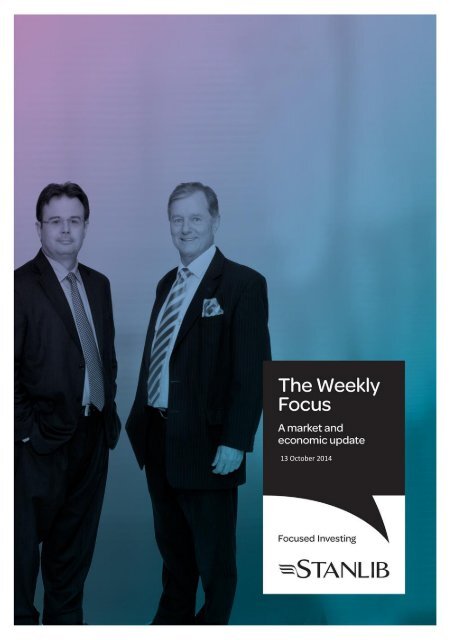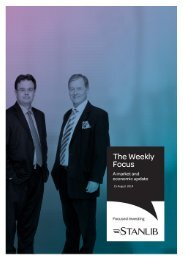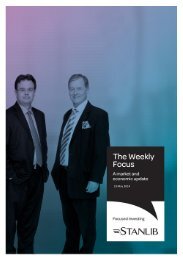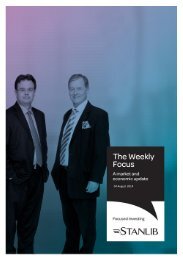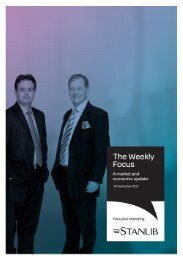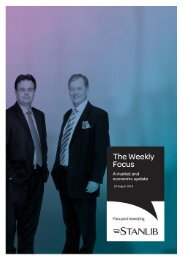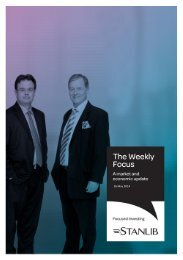FgfHpk
FgfHpk
FgfHpk
You also want an ePaper? Increase the reach of your titles
YUMPU automatically turns print PDFs into web optimized ePapers that Google loves.
13 October 2014
Contents<br />
Contents .................................................................................................................................... 2<br />
Newsflash .................................................................................................................................. 3<br />
Market Comment ........................................................................................................................................................... 3<br />
How about Bonds and SA Listed Property? .................................................................................................................... 4<br />
Other Commentators ...................................................................................................................................................... 4<br />
Economic Update ....................................................................................................................... 6<br />
Weekly Market Analysis ............................................................................................................. 7<br />
STANLIB Money Market Fund ......................................................................................................................................... 8<br />
STANLIB Enhanced Yield Fund ........................................................................................................................................ 8<br />
STANLIB Income Fund ..................................................................................................................................................... 8<br />
STANLIB Flexible Income Fund ........................................................................................................................................ 9<br />
STANLIB Multi-Manager Absolute Income Fund ............................................................................................................ 9
Newsflash<br />
Pessimism on world markets is rising quickly and plenty of bad news is being bandied about in the media, usually a<br />
good sign that the bottom is not far away.<br />
Market Comment<br />
<br />
<br />
<br />
Having said that there was a 60% possibility the market correction was bottoming a week ago, one<br />
acknowledges that the 40% possibility that it had NOT bottomed then is certainly winning, as the JSE All<br />
Share Index continued its correction with gusto on Friday, although today looks better.<br />
This has been a serious clean-out/correction and it is global, with very few shares spared.<br />
The US S&P 500 Index is down around 5.3%, while the MSCI World Index is down a heftier 7.8% in dollar<br />
terms, back at its November 2013 level. The weaker non-US currencies, relative to the dollar, have<br />
aggravated the fall in this index.<br />
The MSCI Emerging Markets Index is down 10% in dollars, while the JSE ALSI in dollar terms is down 13.5%<br />
from the recent high.<br />
At time of writing on Monday morning before the pickup, the All Share Index in rands is -10.4% or 5,426<br />
points below its record high of 52,323, while the previously powerful Industrial Index is -9% and the strong<br />
Financial Index is -9.4%.<br />
<br />
<br />
<br />
<br />
<br />
<br />
<br />
<br />
<br />
<br />
<br />
As mentioned, very few shares are escaping, with the biggest share Billiton (9.9% of the ALSI) down some<br />
23% from its record high in rand terms, back at 2008 prices, while Anglo American, now only the 6 th biggest<br />
share at 5%, was on Friday down about 20% from its recent high and down a massive 55% from its record<br />
high in 2008, trading now at 2006 prices!<br />
Both Anglo and Billiton are bouncing today as the day progresses.<br />
Even Woolies is down 19%, trading at November 2012 prices, i.e. almost two years ago!<br />
Clearly some of the big rand hedges are hurting, apart from Billiton and Anglos. Richemont is down 22%, back<br />
at 17-months ago levels, while Sasol is down 15% and the mighty SA Breweries is down 15%.<br />
One of the previously great shares that actually went up during the 2008/9 crash, Shoprite, is down a<br />
whopping 36% from its record high in late 2012, trading at the same price as around three years ago - down<br />
19% so far in 2014.<br />
The share is, however, still trading at 19 times earnings of the past 12 months (the PE ratio) and on a dividend<br />
yield of 2.6%, is still below the 3.1% dividend yield of the JSE All Share Index, which by the way is almost its<br />
highest dividend yield in 5 years (the ALSI dividend yield), partly because companies are paying more of their<br />
profits in dividends.<br />
One of the more extraordinary moves today is the 4.4% jump in the share price of Capitec, to yet another<br />
record high, 28% above its low of two months ago during the African Bank issue.<br />
The JSE’s ALSI PE ratio is now around 16 (trading at 16 times earnings of the past 12 months), still higher than<br />
the 14.6 times average of the past 20 years, although arguably still affected on the high side by some of the<br />
big rand hedges, like Naspers and SAB.<br />
If the US stock market correction extends to 7% from the current 5.3%, then the JSE correction could extend<br />
to, say 12.5% or so.<br />
Pessimism on world markets is rising quickly and plenty of bad news is being bandied about in the media<br />
(very little good news). It could reach a peak quite soon, which usually represents an excellent buying<br />
opportunity; exactly when, no-one knows. It could even be there now.<br />
However, if one wishes to up-weight one’s equity allocation, gradually buying into this downturn should<br />
prove rewarding.
Just one cautionary: we are into the 6 th year of the bull market (possibly the 8 th innings of a 9 innings bull<br />
market, to compare it to a baseball game), so one needs to bear that in mind. One would therefore be more<br />
cautious than if we were only in the 2 nd or 3 rd innings of the bull market.<br />
One or two market-letter writers have pointed out the statistics relating to the 3 rd year of a US Presidential<br />
cycle, which started for President Obama on 1 st October. The 3 rd year has since the 1930’s so far has never<br />
produced a negative stock market total return in the US (including dividends) and in fact has produced<br />
returns way higher than years one, two and four.<br />
Hopefully that statistic continues to play out. Usually most of the returns occur between October and April.<br />
Of course, one cannot rely on this happening (3 rd year doing so well), but it is an interesting factor that does<br />
encourage the bulls among us; and why not?<br />
Credit Suisse’s latest Global Equity Strategy, written by Andrew Garthwaite, notes that US director buying of<br />
their company shares has recently been strong, which is positive and net speculative positions on the S&P<br />
500 Index in the US are close to a three year low, which is also a good sign for equities being close to the<br />
bottom.<br />
Meanwhile ongoing excess liquidity remains good for equities.<br />
How about Bonds and SA Listed Property?<br />
<br />
<br />
<br />
<br />
As is fairly customary during a stock market correction, bonds improve as yields decline and prices rise.<br />
Investors sell out of the riskier equities and buy bonds. This time investors are emboldened to buy bonds on<br />
the back of news of weak growth in many regions, along with lower inflation, a typically good combination<br />
for bonds.<br />
Offshore bond yields have fallen quite sharply, with the US 10-year yield down from 2.49% at end September<br />
to 2.28% today, driving prices and values higher. This is the lowest yield/highest price since the “taper<br />
tantrum” in June 2013.<br />
Offshore property shares have turned upwards by 2.5% after their sharp 6.8% correction and are now down<br />
about 4.7%.<br />
Our All Bond Index here in SA is up 1.5% in October (yields down) and is up 7.3% so far in 2014. This is<br />
positive for SA Listed Property, which is still showing a total return in 2014 of around 13.5%.<br />
Other Commentators<br />
US MARKET ANALYST ELAINE GARZARELLI<br />
<br />
<br />
<br />
<br />
<br />
<br />
Recent US Fed (central bank) minutes reassured that policy is data-dependent and there is no immediate<br />
intention to tighten.<br />
Members of the Fed were concerned about the effect that weak global growth and the stronger dollar could<br />
have on slowing the US economy.<br />
Garza’s quants system reading declined to 62.5% from 66% last week, due to the downgrade to neutral of the<br />
ECRI leading indicator. This indicator shows potential changes in the economic cycle.<br />
Corrections of 4 to 7% are normal during bull markets. Garza’s system still indicates a fair value for the S&P<br />
500 Index some 24% higher than current levels.<br />
Her sentiment indicator (bullishness of US investment advisors) declined to 45.5%, but is only neutral, not yet<br />
bullish for the market (contrarian indicator).<br />
She likes the US economy, with only housing restrained due to slow household formation, but expects it to<br />
stabilise over the next year.
BCA RESEARCH<br />
<br />
<br />
<br />
<br />
<br />
Conventional wisdom has it that a strong dollar undermines US equities and vice versa.<br />
BCA, however, expects a period ahead when both the US dollar and US equities appreciate, albeit with<br />
substantial volatility.<br />
The dollar is still extremely overbought though, so it could have a period of sideways movement or even<br />
some contraction relative to the euro etc.<br />
US equities should outperform global equities over the next 6 months or so.<br />
BCA still expects US equities to outperform US bonds and cash.<br />
Paul Hansen<br />
Director: Retail Investing
Economic Update<br />
Locally, manufacturing production growth decreased by a more moderate1.2% y/y in August after falling by a<br />
revised 8.1% in July. M/m, seasonally adjusted, production grew by 2.2% in August based on an increase in<br />
production of16.2% m/m (+3.3pp) of basic iron and steel and a 16.6% (+1.4pp) rise in the production of motor<br />
vehicles, parts and accessories. However, six of the ten manufacturing sub-divisions tracked by Stats SA indicated<br />
contractions in production in August, the most notable declines being food and beverages (-5.3% m/m, -1.3pp);<br />
wood, paper, publishing and printing (-5.5%, -0.5pp) and petroleum, chemical, rubber and plastics (-0.8%, -0.2pp).<br />
Looking ahead, the moderation in manufacturing production growth in August is welcome, although there is still risk<br />
that the sub-sectors continue to contract both y/y and m/m for the remainder of the year which would mean that<br />
manufacturing activity will have to register a large growth of at least 8.0% m/m in September for this sector to<br />
contribute positively to Q3 GDP. Given the still relatively modest trends in the PMI business activity indicator in<br />
September (index level of 53.0), this is probably an unlikely ending and the key productive sectors of mining and<br />
manufacturing are likely to contribute negatively to Q3 GDP growth.<br />
Offshore, the IMF revised down South Africa’s growth forecast for 2014 to 1.4% from 1.7% in April 2014. This is<br />
exactly in-line with our own forecast. The Reserve Bank’s forecast is for South Africa’s GDP to grow by 1.5%, while the<br />
National Treasury has a forecast of 1.8%. For 2015, the IMF revised South Africa’s growth outlook down to 2.3% from<br />
2.7% in April 2014. This is slightly below our own forecast of 2.4%, and the Reserve Bank’s forecast of 2.8%. The IMF<br />
have revised down most country’s growth estimates for 2014 and 2015, especially the Euro-area, Japan, Russia, Brazil,<br />
and the Middle East. In contrast the growth outlook for India, Canada, Mexico, and the United States have been<br />
revised up somewhat. The IMF is still fairly optimistic about the growth outlook for Sub-Saharan Africa despite the<br />
spread of Ebola.<br />
Kevin Lings is currently at the IMF Annual General Meetings in Washington and an additional update on the outcomes<br />
of the IMF and IIF annual meetings in Washington will be the main theme next week.<br />
In the emerging markets, in a recent communication by the Reserve Bank of Zimbabwe an announcement was made<br />
that the country was importing US$ 45 million worth of coins. The main purpose of the operation is to smooth<br />
transactions in the country as it faces shortages of coins in some areas. According to the document some consumers<br />
were given sweets and vouchers instead of change because of the shortage. What aggravated that matter was that<br />
the Bank of Botswana announced that it was phasing out its current coins for new coins which resulted in businesses<br />
no longer accepting Pula coins. The previous attempt of importing coins failed as the freight costs of the exercise was<br />
more than the value of the coins. In that US$45 million dollars, US$ 25 million will be Rand denominated coins and the<br />
outstanding US$20 million will be special coins to be pegged to the US Dollar coins but will be minted in South Africa.<br />
The Reserve Bank re-iterated that this is not a way to re-introduce the Zim Dollar. The impact on inflation is expected<br />
to be minimal and short-lived as the value of the coins is less than 1% of GDP and the country is facing deflationary<br />
pressures from a slowing economy. Delivery of the first batch of coins is expected in November.<br />
Headline inflation in Kenya eased to 6.6% for the month of September and is the first time the inflation rate<br />
dropped in 5 months. This is down from the 8.36% registered in the previous month and is the lowest inflation has<br />
been since April 2014 with most food categories registering a price decrease on a monthly basis. The sharp reversal in<br />
the inflation rate is as a result of the base effects from the increase in the taxes introduced in September 2013<br />
wearing off. The upward trend in the inflation rate is expected to continue though. This gives the Central Bank of<br />
Kenya some breathing space in terms of keeping monetary policy stable at current levels and we expect rates to be<br />
kept on hold for the rest of the year.<br />
Please follow our regular economic updates on twitter @lingskevin<br />
Kevin Lings, Laura Jones & Kganya Kgare<br />
(STANLIB Economics Team)
Weekly Market Analysis<br />
Currencies/ Indices/ Commodities<br />
Friday’s Close<br />
10/10/14<br />
Weekly Move<br />
(%)<br />
YTD<br />
(%)<br />
Indices<br />
*MSCI World – US Dollar 1626.68 -2.90 -2.07<br />
*MSCI World – Rand 18074.21 -4.74 5.11<br />
*MSCI Emerging Market – US Dollar 989.87 -0.74 -1.28<br />
*MSCI Emerging Market – Rand 10998.54 -2.62 5.96<br />
All Share Index – US Dollar 4237.81 -1.23 -5.18<br />
All Share Index – Rand 47092.25 -3.13 1.81<br />
All Bond Index 467.55 1.52 7.07<br />
Listed Property J253 1583.80 0.25 13.49<br />
Currencies<br />
US Dollar/Rand 11.11 -1.92 7.37<br />
Euro/Rand 14.04 -1.11 -2.69<br />
Sterling/Rand 17.86 -1.29 2.94<br />
Euro/US Dollar 1.26 0.90 -8.11<br />
Commodities<br />
Oil Brent Crude Spot Price ($/bl) 89.91 -2.04 -18.85<br />
Gold Price $/oz 1223.61 2.73 1.50<br />
Platinum Price S/oz 1262.50 3.06 -7.98<br />
Source: I-Net Bridge<br />
* MSCI - Morgan Stanley Capital International
Rates<br />
These rates are expressed in nominal and effective terms and should be used for indication purposes ONLY.<br />
STANLIB Money Market Fund<br />
Nominal:<br />
Effective:<br />
5.99% per annum<br />
6.16% per annum<br />
STANLIB is required to quote an effective rate which is based upon a seven-day rolling average yield for Money<br />
Market Portfolios. The above quoted yield is calculated using an annualised seven-day rolling average as at 12 October<br />
2014. This seven- day rolling average yield may marginally differ from the actual daily distribution and should not be<br />
used for interest calculation purposes. We however, are most happy to supply you with the daily distribution rate on<br />
request, one day in arrears. The price of each participatory interest (unit) is aimed at a constant value. The total return<br />
to the investor is primarily made up of interest received but, may also include any gain or loss made on any particular<br />
instrument. In most cases this will merely have the effect of increasing or decreasing the daily yield, but in an extreme<br />
case it can have the effect of reducing the capital value of the portfolio.<br />
STANLIB Enhanced Yield Fund<br />
Effective Yield: 6.39%<br />
STANLIB is required to quote a current yield for Income Portfolios. This is an effective yield. The above quoted yield<br />
will vary from day to day and is a current yield as at 10 October 2014. The net (after fees) yield on the portfolio will be<br />
published daily in the major newspapers together with the “all-in” NAV price (includes the accrual for dividends and<br />
interest). This yield is a snapshot yield that reflects the weighted average running yield of all the underlying holdings<br />
of the portfolio. Monthly distributions will consist of dividends and interest. Interest will also be exempt from tax to<br />
the extent that investor’s are able to make use of the applicable interest exemption as currently allowed by the<br />
Income Tax Act. The portfolio’s underlying investments will determine the split between dividends and interest.<br />
STANLIB Income Fund<br />
Effective Yield: 7.18%<br />
Collective Investment Schemes in Securities (CIS) are generally medium to long term investments. The value of<br />
participatory interests may go down as well as up and past performance is not necessarily a guide to the future. A<br />
schedule of fees and charges and maximum commissions is available on request from the company/scheme. CIS can<br />
engage in borrowing and scrip lending. Commission and incentives may be paid and if so, would be included in the<br />
overall costs.” The above quoted yield will vary from day to day and is a current yield as at 10 October 2014.
STANLIB Extra Income Fund<br />
Effective Yield: 6.69%<br />
Collective Investment Schemes in Securities (CIS) are generally medium to long term investments. The value of<br />
participatory interests may go down as well as up and past performance is not necessarily a guide to the future. A<br />
schedule of fees and charges and maximum commissions is available on request from the company/scheme. CIS can<br />
engage in borrowing and scrip lending. Commission and incentives may be paid and if so, would be included in the<br />
overall costs.<br />
Fluctuations or movements in exchange rates may cause the value of underlying international investments to go up or<br />
down.” The above quoted yield will vary from day to day and is a current yield as at 10 October 2014.<br />
STANLIB Flexible Income Fund<br />
Effective Yield: 7.01%<br />
Collective Investment Schemes in Securities (CIS) are generally medium to long term investments. The value of<br />
participatory interests may go down as well as up and past performance is not necessarily a guide to the future. A<br />
schedule of fees and charges and maximum commissions is available on request from the company/scheme. CIS can<br />
engage in borrowing and scrip lending. Commission and incentives may be paid and if so, would be included in the<br />
overall costs.” The above quoted yield will vary from day to day and is a current yield as at 10 October 2014.<br />
STANLIB Multi-Manager Absolute Income Fund<br />
Effective Yield: 5.80%<br />
Collective Investment Schemes in Securities (CIS) are generally medium to long term investments. The value of<br />
participatory interests may go down as well as up and past performance is not necessarily a guide to the future. A<br />
schedule of fees and charges and maximum commissions is available on request from the company/scheme. CIS can<br />
engage in borrowing and scrip lending. Commission and incentives may be paid and if so, would be included in the<br />
overall costs.” The above quoted yield will vary from day to day and is a current yield as at 10 October 2014.
Glossary of terminology<br />
Bonds<br />
A bond is an interest-bearing debt instrument, traditionally issued by governments as part of<br />
their budget funding sources, and now also issued by local authorities (municipalities),<br />
parastatals (Eskom) and companies. Bonds issued by the central government are often<br />
called “gilts”. Bond issuers pay interest (called the “coupon”) to the bondholder every 6<br />
months. The price/value of a bond has an inverse relationship to the prevailing interest rate,<br />
so if the interest rate goes up, the value goes down, and vice versa. Bonds/gilts generally<br />
have a lower risk than shares because the holder of a gilt has the security of knowing that<br />
the gilt will be repaid in full by government or semi-government authorities at a specific<br />
time in the future. An investment in this type of asset should be viewed with a 3 to 6 year<br />
horizon.<br />
Cash<br />
Collective<br />
Investments<br />
Compound Interest<br />
Dividend Yields<br />
Dividends<br />
Earnings per share<br />
An investment in cash usually refers to a savings or fixed-deposit account with a bank, or to<br />
a money market investment. Cash is generally regarded as the safest investment. Whilst it is<br />
theoretically possible to make a capital loss investing in cash, it is highly unlikely. An<br />
investment in this type of asset should be viewed with a 1 to 3 year horizon.<br />
Collective investments are investments in which investors‟ funds are pooled and managed<br />
by professional managers. Investing in shares has traditionally yielded unrivalled returns,<br />
offering investors the opportunity to build real wealth. Yet, the large amounts of money<br />
required to purchase these shares is often out of reach of smaller investors. The pooling of<br />
investors’ funds makes collective investments the ideal option, providing cost effective<br />
access to the world’s stock markets. This is why investing in collective investments has<br />
become so popular the world over and is considered a sound financial move by most<br />
investors.<br />
Compound interest refers to the interest earned on interest that was earned earlier and<br />
credited to the capital amount. For example, if you deposit R1 000 in a bank account at 10%<br />
and interest is calculated annually; your balance will be R1 100 at the end of the first year<br />
and R1 210 at the end of the second year. That extra R10, which was earned on the interest<br />
from the first year, is the result of compound interest ("interest on interest"). Interest can<br />
also be compounded on a monthly, quarterly, half-yearly or other basis.<br />
The dividend yield is a financial ratio that shows how much a company pays out in dividends<br />
each year relative to its share price. The higher the yield, the more money you will get back<br />
on your investment.<br />
When you buy equities offered by a company, you are effectively buying a portion of the<br />
company. Dividends are an investor’s share of a company’s profits, given to him or her as a<br />
part-owner of the company.<br />
Earnings per share is a measure of how much money the company has available for<br />
distribution to shareholders. A company’s earnings per share is a good indication of its<br />
profitability and is generally considered to be the most important variable in determining a<br />
company’s share price.
Equity<br />
Financial Markets<br />
Fixed Interest Funds<br />
Gross Domestic<br />
Product (GDP)<br />
Growth Funds<br />
Industrial Funds<br />
Investment Portfolio<br />
JSE Securities<br />
Exchange<br />
Price to earnings<br />
ratio<br />
Property<br />
Resources and Basic<br />
Industries Funds<br />
A share represents an institution/individual’s ownership in a listed company and is the<br />
vehicle through which they are able to “share” in the profits made by that company. As the<br />
company grows, and the expectation of improved profits increases, the market price of the<br />
share will increase and this translates into a capital gain for the shareholder. Similarly,<br />
negative sentiment about the company will result in the share price falling. Shares/equities<br />
are usually considered to have the potential for the highest return of all the investment<br />
classes, but with a higher level of risk i.e. share investments have the most volatile returns<br />
over the short term. An investment in this type of asset should be viewed with a 7 to 10 year<br />
horizon.<br />
Financial markets are the institutional arrangements and conventions that exist for the issue<br />
and trading of financial instruments.<br />
Fixed interest funds invest in bonds, fixed-interest and money market instruments. Interest<br />
income is a feature of these funds and, in general, capital should remain stable.<br />
The Gross Domestic Product measures the total volume of goods and services produced in<br />
the economy. Therefore, the percentage change in the GDP from year to year reflects the<br />
country's annual economic growth rate.<br />
Growth funds seek maximum capital appreciation by investing in rapidly growing companies<br />
across all sectors of the JSE. Growth companies are those whose profits are in a strong<br />
upward trend, or are expected to grow strongly, and which normally trade at a higher-thanaverage<br />
price/earnings ratio.<br />
Industrial funds invest in selected industrial companies listed on the JSE, but excluding all<br />
companies listed in the resources and financial economic groups.<br />
An investment portfolio is a collection of securities owned by an individual or institution<br />
(such as a collective investment scheme). A funds‛ portfolio may include a combination of<br />
financial instruments such as bonds, equities, money market securities, etc. The theory is<br />
that the investments should be spread over a range of options in order to diversify and<br />
spread risk.<br />
The primary role of the JSE Securities Exchange is to provide a market where securities can<br />
be freely traded under regulated procedures.<br />
Price to earnings ratio or p: e ratio is calculated by dividing the price per share by the<br />
earnings per share. This ratio provides a better indication of the value of a share, than the<br />
market price alone. For example, all things being equal, a R10 share with a P/E of 75 is much<br />
more “expensive” than a R100 share with a P/E of 20.<br />
Property has some attributes of shares and some attributes of bonds. Property yields are<br />
normally stable and predictable because they comprise many contractual leases. These<br />
leases generate rental income that is passed through to investors. Property share prices<br />
however fluctuate with supply and demand and are counter cyclical to the interest rate<br />
cycle. Property is an excellent inflation hedge as rentals escalate with inflation, ensuring<br />
distribution growth, and property values escalate with inflation ensuring net asset value<br />
growth. This ensures real returns over the long term.<br />
These funds seek capital appreciation by investing in the shares of companies whose main<br />
business operations involve the exploration, mining, distribution and processing of metals,<br />
minerals, energy, chemicals, forestry and other natural resources, or where at least 50<br />
percent of their earnings are derived from such business activities, and excludes service<br />
providers to these companies.
Smaller Companies<br />
Funds<br />
Value Funds<br />
Growth Funds<br />
Smaller Companies Funds seek maximum capital appreciation by investing in both<br />
established smaller companies and emerging companies. At least 75 percent of the fund<br />
must be invested in small- to mid-cap shares which fall outside of the top 40 JSE-listed<br />
companies by market capitalisation.<br />
These funds aim to deliver medium- to long-term capital appreciation by investing in value<br />
shares with low price/earnings ratios and shares which trade at a discount to their net asset<br />
value.<br />
Growth funds seek maximum capital appreciation by investing in rapidly growing companies<br />
across all sectors of the JSE. Growth companies are those whose profits are in a strong<br />
upward trend, or are expected to grow strongly, and which normally trade at a higher-thanaverage<br />
price/earnings ratio.<br />
Sources: Unit Trust and Collective Investments (September 2007), The Financial Sector Charter Council, Personal Finance (30 November 2002),<br />
Introduction to Financial Markets, Personal Finance, Quarter 4 2007, Investopedia (www.investopedia.com) and The South African Financial<br />
Planning Handbook 2004.
Disclaimer<br />
The price of each unit of a domestic money market portfolio is aimed at a constant value. The total return to the investor is primarily made up of<br />
interest received but, may also include any gain or loss made on any particular instrument. In most cases this will merely have the effect of<br />
increasing or decreasing the daily yield, but in an extreme case it can have the effect of reducing the capital value of the portfolio. Collective<br />
Investment Schemes in Securities (CIS) are generally medium to long term investments. The value of participatory interests may go down as well as<br />
up and past performance is not necessarily a guide to the future. An investment in the participations of a CIS in securities is not the same as a<br />
deposit with a banking institution. CIS are traded at ruling prices and can engage in borrowing and scrip lending. A schedule of fees and charges and<br />
maximum commissions is available on request from STANLIB Collective Investments Ltd (the Manager). Commission and incentives may be paid and<br />
if so, would be included in the overall costs. A fund of funds is a portfolio that invests in portfolios of collective investment schemes, which levy<br />
their own charges, which could result in a higher fee structure for these portfolios. Forward pricing is used. Fluctuations or movements in exchange<br />
rates may cause the value of underlying international investments to go up or down. TER is the annualised percent of the average Net Asset Value<br />
of the portfolio incurred as charges, levies and fees. A higher TER ratio does not necessarily imply a poor return, nor does a low TER imply a good<br />
return. The current TER cannot be regarded as an indication of future TERs. Portfolios are valued on a daily basis at 15h30. Investments and<br />
repurchases will receive the price of the same day if received prior to 15h30. Liberty is a full member of the Association for Savings and Investments<br />
of South Africa. The Manager is a member of the Liberty Group of Companies.<br />
As neither STANLIB Wealth Management Limited nor its representatives did a full needs analysis in respect of a particular investor, the investor<br />
understands that there may be limitations on the appropriateness of any information in this document with regard to the investor’s unique<br />
objectives, financial situation and particular needs. The information and content of this document are intended to be for information purposes only<br />
and STANLIB does not guarantee the suitability or potential value of any information contained herein. STANLIB Wealth Management Limited does<br />
not expressly or by implication propose that the products or services offered in this document are appropriate to the particular investment<br />
objectives or needs of any existing or prospective client. Potential investors are advised to seek independent advice from an authorized financial<br />
adviser in this regard. STANLIB Wealth Management Limited is an authorised Financial Services Provider in terms of the Financial Advisory and<br />
Intermediary Services Act 37 of 2002 (Licence No. 26/10/590)<br />
Compliance No.: 4130HX<br />
17 Melrose Boulevard, Melrose Arch, 2196<br />
P O Box 202, Melrose Arch, 2076<br />
T 0860123 003 (SA Only)<br />
T+27(0)11 448 6000<br />
E contact@stanlib.com<br />
Website www.stanlib.com<br />
STANLIB Wealth Management Limited<br />
Reg. No. 1996/005412/06<br />
Authorised FSP in terms of the FAIS Act, 2002 (Licence<br />
No. 26/10/590)<br />
STANLIB Collective Investments Limited<br />
Reg. No. 1969/003468/06


